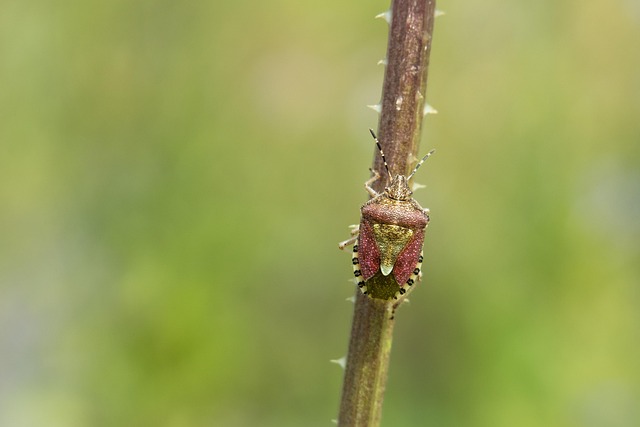Bed bugs, despite their tiny size, cause significant discomfort and financial strain. Traditional chemical control methods pose health and environmental risks. However, a growing trend towards eco-friendly bed bug treatments using natural ingredients, heat, and advanced technology offers safer alternatives. Hiring licensed specialists for tailored eco-friendly solutions enhances success rates and prevents resistance. Post-treatment, implement regular inspections, cleaning, and prevention strategies to avoid future infestations while minimizing the environmental impact.
In the face of persistent bed bug infestations, understanding effective control methods is paramount. This article explores both traditional and eco-friendly bed bug treatments, highlighting the significance of licensed specialists in ensuring reliable and swift eradication. We delve into the impact of these pests, emerging green solutions, and practical strategies to prevent future invasions. By adopting these measures, homeowners can reclaim their spaces with confidence, knowing their homes are free from these unwelcome visitors.
Understanding Bed Bug Infestations and Their Impact
Bed bugs are small, wingless insects that have become notorious for infesting homes and businesses across the globe. Understanding their behavior and life cycle is crucial to effective control. These pests feed on human blood, typically at night when hosts are asleep. They leave behind itchy bites and can cause significant psychological distress. A bed bug infestation goes beyond mere discomfort; it can lead to a host of issues, including loss of sleep, anxiety, and even financial strain due to the cost of treatment.
The impact of bed bugs extends beyond individuals—they disrupt communities and pose challenges for property managers and landlords. Traditional control methods often rely on harsh chemicals, but these eco-unfriendly treatments can have adverse effects on humans, pets, and the environment. Thankfully, there’s a growing trend towards eco-friendly bed bug treatments that are both effective and safe. Licensed specialists now offer innovative solutions, utilizing heat treatments, natural repellents, and other non-toxic methods to eradicate these pests while minimizing risks.
The Rise of Eco-Friendly Bed Bug Control Methods
In recent years, there’s been a notable shift towards eco-friendly bed bug control methods as consumers and professionals alike seek more sustainable solutions to this persistent pest problem. Traditional chemical treatments have long dominated the market, but growing environmental concerns and health risks associated with certain pesticides have prompted a search for safer alternatives. Eco-friendly bed bug treatments leverage natural ingredients, heat, cold, and innovative technology to effectively eradicate these pesky intruders without compromising the well-being of humans or the environment.
These environmentally conscious approaches not only reduce exposure to harmful chemicals but also offer long-lasting results. From plant-based pesticides derived from neem oil and essential oils like lavender and peppermint, to heat treatment methods that exploit bed bugs’ sensitivity to high temperatures, these eco-friendly solutions are gaining popularity among those seeking reliable and safe bed bug control.
Benefits of Hiring Licensed Specialists for Effective Treatment
Hiring licensed specialists for bed bug control offers numerous benefits, especially when it comes to effective and reliable treatment options. These professionals are equipped with the knowledge and skills to handle bed bug infestations using advanced techniques that ensure a faster elimination process. One of the key advantages is their expertise in eco-friendly bed bug treatments, which minimise the use of harsh chemicals, making them safer for both residents and the environment.
By employing licensed specialists, homeowners can expect a more tailored approach to their specific infestation. These experts can identify the extent of the issue and recommend suitable treatment plans, including heat or cold treatments, or targeted applications of natural pesticides. This personalised method enhances success rates and reduces the likelihood of bed bugs developing resistance to treatments, which is a growing concern in the pest control industry.
Strategies and Tips for Preventing Future Bed Bug Infestations
After successfully addressing a bed bug infestation, it’s crucial to implement strategies and tips for preventing future invasions. Eco-friendly bed bug treatments are an excellent starting point. These methods use non-toxic chemicals or natural remedies to eliminate pests while minimizing environmental impact. Regularly inspecting your bedding, furniture, and walls for any signs of bed bugs is vital. Also, maintain a clean living space, as these insects are attracted to dirt and debris.
Vacuuming regularly with a high-quality vacuum cleaner equipped with a specialized bed bug attachment can help remove eggs and adults from crevices and fabrics. Additionally, sealing gaps around pipes, electrical wires, and furniture legs can limit their access points. Avoiding second-hand furniture and carefully inspecting any items before bringing them into your home is recommended. Lastly, educate yourself and others about the signs of bed bugs to enable swift action should an infestation occur again.
When dealing with bed bugs, hiring licensed specialists offering eco-friendly bed bug treatments is a smart choice. These professionals are equipped with the knowledge and tools to eliminate infestations effectively while minimizing environmental impact. By combining advanced techniques with a deep understanding of these pests’ behavior, they ensure a successful and safe outcome. Moreover, preventing future invasions through proactive strategies is key to maintaining a bug-free environment. Remember that timely action and expert intervention can make all the difference in successfully combating bed bug issues.
